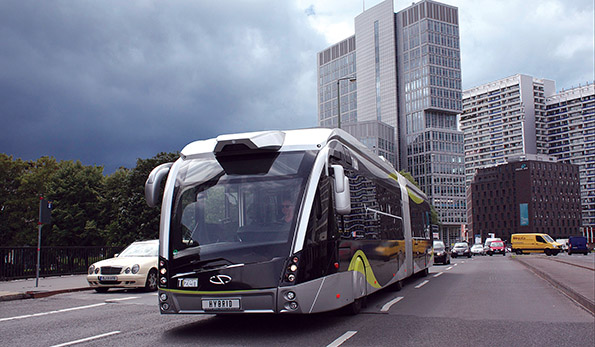
By Doug Jack
With headquarters and two factories near the city of Poznan in Western Poland, Solaris is one of the more innovative bus builders in the world. Last year the company sold 1,302 vehicles, the highest number to date in its 18-year history.
“We owe last year’s success to our customers who rely on us and return year after year to maintain this fruitful co-operation,” says Solaris Chief Executive Solange Olszewska. “As we can observe, the majority of orders were placed by our long-time customers. It proves the quality of our products and after-sales service. We will concentrate not only on large contracts. We value every client, irrespective of the number of buses that they order.”
—————————————————————————————————————————————
YOU MIGHT ALSO LIKE:
—————————————————————————————————————————————
Preferring volume production of relatively standardized products, Solaris distinguishes itself by the enormous variety of models that it can offer. Such flexibility and variety would be impossible for a larger manufacturer. From the basic specifications and lists of approved options, which generally are the limit, Solaris builds all its structures in stainless steel but can vary the length, width and height for all sorts of city, suburban and interurban applications.
The Solaris range is available with diesel, CNG and biogas engines, also hybrid and all-electric traction. It includes trolleybuses powered from overhead wires, and more recently low-floor trams.
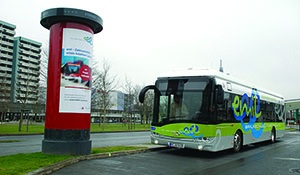
The range starts with the Alpino midibus with a full low-floor layout at just over 28 feet and a low-entry version slightly over 29 feet. Both have an overall width slightly under 8 feet and are suitable for hilly areas with narrow roads, and use Cummins 6.7 liter engines and either ZF or Voith fully automatic gearboxes. There is also an all-electric version of the longer low-entry model.
Moving up the range, the Urbino 10 is just under 10 meters. The Urbino 12 is one of the most popular models. With a full low-floor layout, built to an overall length of 39 feet, 4 inches, either a DAF (Paccar) or Cummins engine mounts vertically in line and offset at the rear opposite the curb, which facilitates a third double-width door behind the rear axle for busy city routes. It is available with a CNG engine or as a low-entry vehicle with a standard rear axle and without a door behind that point. This layout is popular in Nordic markets and for suburban and short interurban routes. This Urbino model is also available as an all-electric version.
Built to 47 feet, 10 inches on three axles, the Urbino 15 can have either a full low-floor or a low-entry layout with either a diesel, CNG or biogas engine. These longer vehicles sell very well in Sweden. The third axle steers, giving a turning circle that is little more than a standard two-axle bus without any need for articulation.
Solaris also offers the articulated Urbino 18 and 18.75 models. The former has an overall length of just over 59 feet; the latter about 61 feet, 6 inches, giving an extra row of seats in the front section.
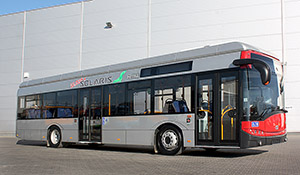
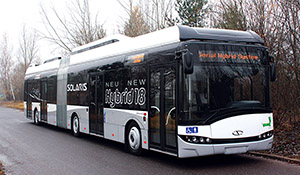
The 42 foot, 2 inch Interurbino interurban coach has its floor about 2 feet, 9 inches above the ground with deeper than normal luggage racks in the interior, because drivers and passengers do not like to get in and out of a vehicle in cold winter conditions to put relatively small luggage in underfloor lockers.
The Solaris Trollino all-electric buses are available at 39 feet, 4 inches and 47 feet, 10 inches on three axles as well as the articulated version at just over 59 feet. All the Urbino and Trollino models have the same styling, with a distinctive windshield that is lower on the curb side, giving drivers very good forward vision in that area.
The MetroStyle option that looks more like a tram has fitted on Bus Rapid Transit vehicles for customers in France, as well as trolleybus versions for the city of Salzburg in Austria.
Solaris has always been very good at reading trends in the industry and being faster to react than major manufacturers who invariably have strict product planning, marketing and budget controls. It was one of the first European manufacturers to develop hybrid buses and presented its first hybrid bus in 2006, an articulated model with an Allison EP parallel hybrid drive system and a Cummins 8.9 liter engine mounted vertically and offset in line in the front half of the vehicle and a 600V battery pack. The second axle was a driven ZF portal. The third axle in the trailer section is also portal but undriven.
Finding that the engine was larger than necessary, the second generation used a smaller Cummins 6.7 liter engine and the same Allison hybrid drive system mounted in the trailer section of the bus, driving into the third axle, which gave considerable savings in fuel consumption. The batteries and inverter module are mounted on the roof, so the interior layout was the same as a conventional diesel-powered Urbino articulated bus.
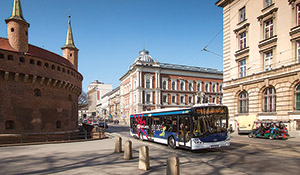
By 2009, Solaris could also offer the option of a hybrid 39 foot, 4 inch bus with a Cummins engine and Eaton parallel hybrid drive system with lithium-ion batteries matched to an automated 6-speed gearbox. One of the largest customers for this version became the French group Transdev, running services in the French island of La Réunion in the Indian Ocean.
By 2010, Solaris offered the option of a Voith Turbo hybrid drive system in the Urbino articulated bus. On these vehicles, electrical energy was stored in super capacitors, which could store electrical energy for a short time to give high power on starts. Customers in Germany procured 50 units.
The next Solaris hybrid launched in Hanover in September 2010 — an articulated bus with a Vossloh Keipe series hybrid system using lithium-phosphate batteries and super capacitors mounted at roof level, plus a plug-in external charging connection. The batteries could recharge by not only the generator and braking, but externally. This vehicle had a Cummins engine connected to a GPS system that could switch off the engine so that the vehicle operated only in electric mode.
Solaris said it deliberately over-engineered the vehicle and put it through a six-month trial program to find out which parts it could eliminate to save weight. The batteries powered systems such as doors, power steering and HVAC, and this technology proved suitable for vehicles powered solely by batteries.
Solaris launched an Alpino all-electric midibus in October 2011 featuring a Vossloh Kiepe traction system and energy management. That vehicle had a range of 60 to 70 miles on a full charge, which took four hours to recharge fully. Following rapid development, the range went up and the recharging time came down to one and a half hours.
Within a year, Solaris built and launched a full size 39 foot, 4 inch all-electric bus with plans for an articulated version, all with lithium-ion batteries and a Vossloh Kiepe electric motor with fast charging during a daily duty cycle.
The city of Braunschweig in Germany ordered one two-axle and four articulated buses recharged by an inductive system at each terminal. The buses parked in a lay-by at each end of the route and took a fast charge from plates mounted in the road surface, without any physical connection. Solaris can also offer the option of all-electric buses that can take a fast charge from an overhead gantry, using a physical connection. While the price of an all-electric bus in Europe is probably around twice that of the equivalent diesel model, the cost of electricity is much lower than diesel. Therefore, the payback period is becoming shorter.
Solaris has supplied buses to customers in 28 countries.
Solaris recently delivered its 10,000th vehicle, an all-electric Urbino to Rheinbahn in Düsseldorf, Germany, the company’s largest and most consistent export market.
